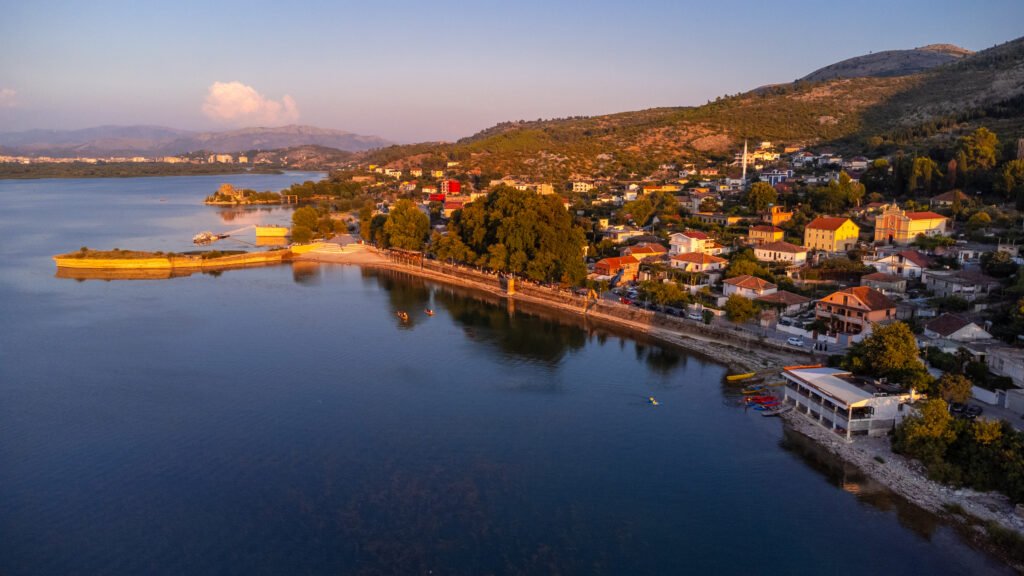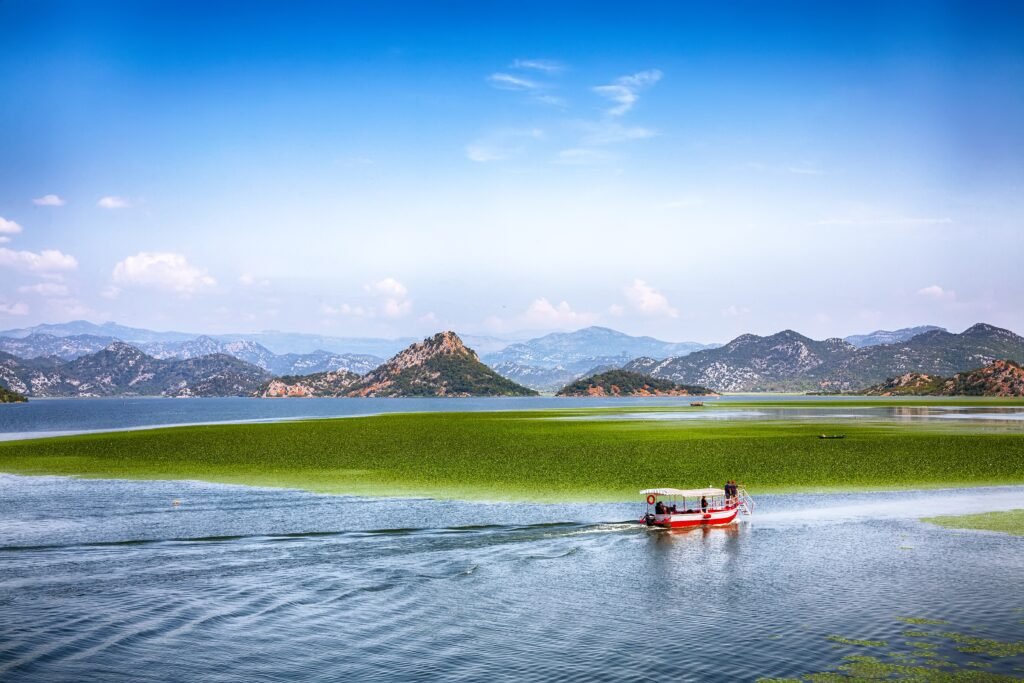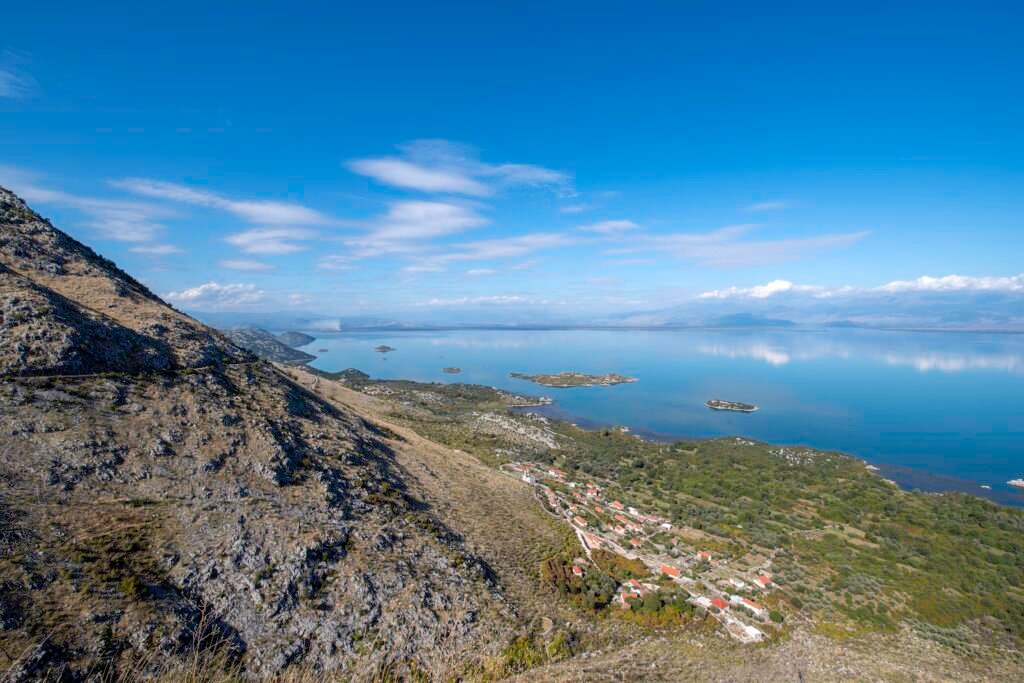The area where biosphere reserve is considered is spread over a large territory and includes several protected areas on both sides of the border:
Type of protected area: National park
Category of protected area: II
IUCN category of protected area: II
Area of the protected area 40000.00 ha
Skadarsko Lake National Park extends through the Montenegrin part of the lake and its shores. The special hydrological specificity of the lake is represented by the sublacustrian springs (eyes, springs) located on its rim, bottom and around the funnel-shaped depressions, which can be up to 60 m deep. The park differs from other national parks in Montenegro, and beyond, by its emphasized limnological characteristics, with extremely diverse algoflora and rich ornithofauna and ichthyofauna. Of the total area of the park, 22,400 ha is water area and 14,600 ha is peripheral land and wetlands. The area of the lake is dominated by freshwater and wetland ecosystems. The presence of endemic representatives of the invertebrate fauna and endemic herpetofauna, as well as an extremely rich bird fauna, is very significant. The vegetation is rich and diverse, with more than 25 rare and endemic species. The clear water of the lake is decorated and largely covered by white and yellow water lilies. In the flooded parts, there is a once widespread subspecies of Skadar oak – Quercus robur ssp. scutariensis, and on the southern shores of the lake, relict chestnut forests survive. The Dalmatian pelican (Pelicanus crispus), a rare and endangered species in Europe, has become a trademark of both the Lake and the Park. The most valuable segment of cultural heritage in the park and its surroundings belongs to the monument fund – medieval monasteries from the reign of Balšić and Crnojević and fortifications from the time of Ottoman domination.
Type of protected area: Nature Park
Category of protected area: V
IUCN category of protected area: V
Area of the protected area: 11985.00 ha
The valley of the Zeta River is a vast entity characterized by great natural and cultural-historical wealth with pronounced biodiversity, landscape and cultural values and features of national and international importance. The area of the Zeta river valley is characterized by a high degree of biodiversity – species and ecosystem;
- 774 species were recorded in the area of the Zeta river valley, of which ten are endemic, a large number of glacial and tertiary relicts, as well as endomorelict species, and in the Zeta river valley, out of 430 protected species of the flora of Montenegro, 273 species were registered, more than 200 significant honey plants were recorded and about 300 species of medicinal plants, the presence of one species whose range does not exceed the borders of the Balkan Peninsula, six taxa that have national protection status, five species that are on the CITES list and one species from the Bern Convention and the Habitat Directive was recorded;
- five habitats of international importance were recorded which are on Annex I of the Habitats Directive – Natura 2000 habitats;
- 63 species of mosses were recorded in the lower course of the Zeta River, and the liverwort Riccia sp. represents a new sub-species for the moss flora of Montenegro;
- in the area of the Zeta River, which belongs to the municipality of Danilovgrad, 27 species of mushrooms were found, of which one species is protected at the national and international level, while the species Phylloporia ribis was registered for the first time in the territory of Montenegro, in the locality of Tunjevo;
- research of the entomofauna of the catchment area of the Zeta River registered 43 species of Odonata (dragonflies), 70 species of Lepidoptera (butterflies), 45 species of Coeloptera (hardwings), 24 species of Heteroptera (water butterflies), 28 species of Orthoptera (orthopterans), three species Mantoddea (mantises), and 8 species of Trichoptera (aquatic moths), of which one species is on the global IUCN Red List, four on the European Red List, seven on Annex II of the Habitats Directive (92/43/EEC) and six species are protected on national level, and two types of Balkan, Mediterranean and European endemics were also recorded;
- 21 species of molluscs are registered in the Zeta area, of which three species of goliath snail are protected at the national level, and an internationally protected species of freshwater crab Austropotamobius pallipes is registered;
- in the upper part of the Zeta stream, the ichthyofauna consists mainly of trout species, while the lower stream (and small tributaries) are mainly inhabited by carp species, and based on the research, the salmonid species that are most endangered and protected by national regulations – soft-lipped trout (Salmo obtusirostris) and grayling ( Salmo marmoratus) as well as brown trout (Salmo farioides);
- ten species of amphibians and 23 species of reptiles have been recorded in the Zeta River valley, of which eight species of amphibians and 18 reptiles are protected at the national level, all recorded species are protected by the Bern Convention, and 22 are protected by the Habitats Directive;
- 265 species of birds have been registered in the Zeta River Valley, the area represents an important migratory corridor, so its importance exceeds the national level, and for seven bird species the area is of special importance for survival at the national level, while for three species it is particularly important as a flyover on spring migration;
- the presence of 24 mammal species was registered in the area of the Zeta valley, among which nine are nationally and internationally endangered and protected;
- ecological values are supplemented with cultural values of the area, represented by intangible and tangible values and provide opportunities for the development and promotion of Danilovgrad as well as the development of citizens’ awareness, education and scientific research.
Type of protected area: Natural monument
Category of protected area: III
IUCN category of protected area: III
Area of the protected area: 2022.20 ha
The area of the Cijevna river canyon represents one of the exceptional natural values of the Morača river basin and the Skadar Lake basin. The Cijevna river basin in Montenegro occupies 130 km2 in the geographical area between the Prokletije mountain massif and the Zeta Plain. The total length of the river is 58.8 km, of which 32.3 km flows through Montenegro.
Type of protected area: Nature Park
Category of protected area: II
IUCN category of protected area: V
Area of the protected area: 1477.00 ha
The Ulcinj Salina is one of the last salt pans on the Eastern coast of the Adriatic Sea; although it is artificially created, it provides conditions for the residence of a large number of species and habitats, and is considered an authentic Mediterranean area. The Ulcinj Salina is one of the most important areas of biodiversity in the region; its importance is reflected in the rich fauna (especially birds and halophilic organisms) and very characteristic habitats that are rapidly disappearing. Of about 526 species that occur in the EU, about 250 species are registered on Salina. 17 globally endangered and 69 rare bird species have been registered in the area of the Ulcinj Salina. The leading species on the territory of the Ulcinj Salina is flamingos – Phoenicopterus roseus. The salt marsh is an important area for migrating birds, especially waterfowl and ducks. It is estimated that over 100,000 waterfowl visit this area in spring and autumn at least for a day, for food and rest. During the winter, over 15,000 birds are present in this area every day. All of the above makes Solana IBA (International Bird Area) an area of international importance for birds, as well as a potential Natura 2000 area and a Ramsar area (wetland of international importance).
We have lots of small ones, depending on the territory: Gorica hill in PG, Main city park in Cetinje, some caves, 6 oak trees in Ulcinj – locations not known, Big beach in Ulcinj…
See the PA registry for Mne on the map.






















